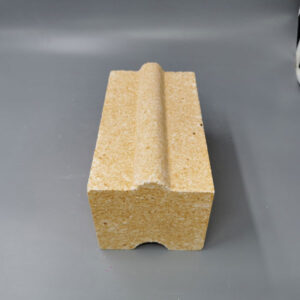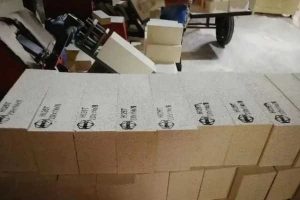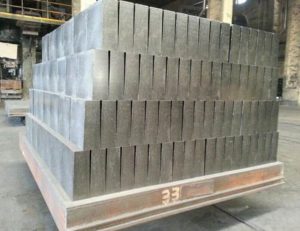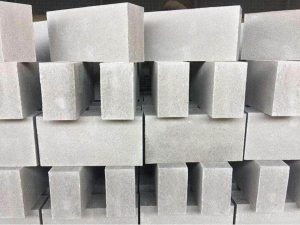1. Introduction of Mullite
Mullite is a refractory raw material with 3Al2O3.2SiO2 crystalline phase as the main component. Mullite is divided into two categories: natural mullite and synthetic mullite. Natural mullite is rare and is generally synthesized. The chemical composition of mullite is Al2O371.8%, SiO228.2%.
The mineral structure is rhombohedral crystal system, the crystals are long columnar, needle-like, chain-like arrangement, needle-like mullite interspersed in the product to form a strong skeleton.
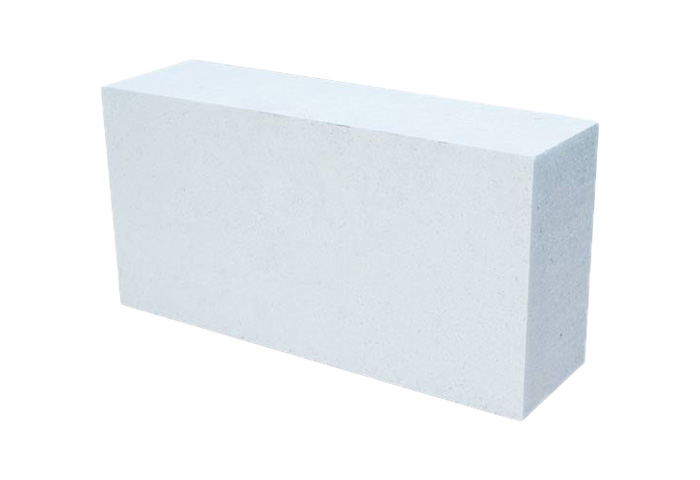
Mullite firebrick is divided into 3 types.
α-mullite, equivalent to pure 3Al2O3-2SiO2, referred to as 3:2 type.
β-mullite, solid solution with excess Al2O3, slightly swollen character, referred to as 2:1 type.
γ-mullite, with a small amount of TiO2 and Fe2O3 in solid solution.
Mullite is chemically stable and insoluble in HF. its density is 3.03g/cm3, Mohs hardness 6~7, frostopunkto 1870℃, termika kondukteco (1000℃) estas 13.8W/(m-K), lineara ekspansiokoeficiento (20~1000℃) estas 5.3×10-6℃, elasta modulo 1.47×1010Pa.
Mullito havas bonajn alttemperaturajn mekanikajn kaj alttemperaturajn termikajn trajtojn, do sintezaj mulitaj obstinaj brikoj kaj iliaj produktoj havas la avantaĝojn de alta denseco kaj pureco, alta struktura forto ĉe alta temperaturo, malalta rampa indico ĉe alta temperaturo, malgranda termika ekspansio rapideco, forta rezisto al kemia erozio, kaj bona termika ŝoko rezisto.
2. Mullita Sinteza Metodo
Mullite-sinteza metodo povas esti dividita en sinteriza metodo kaj elektrofuza metodo. Sinteriza metodo laŭ la maniero de preparo de krudmaterialo kaj ekzistas seka kaj malseka metodo, la seka procezo estas la ingrediencoj estas muelitaj kune, after balling or billet pressing with rotary kiln or tunnel kiln firing.
The wet process is to add water to the compound and grind it into slurry, then press and dewater it into mud cake, vacuum extrusion into mud section or mud billet and then fired.
The electric fusion method is to add the compound to the electric arc furnace, melt in the high temperature formed by the electric arc, cooling precipitation crystal made of natural raw materials ingredients (such as bauxite, ktp.). Can be directly crushed to <1.5mm particles without grinding, and then mixed with other powdered raw materials in the mixer.
Sintering synthesis of mullite is generally carried out at 1650 ~ 1700 ℃. The main process factors affecting the synthesis of mullite by sintering are the purity of raw materials, the fineness of raw materials and the calcination temperature.
Sintering synthesis of podzolite mainly relies on the solid-phase reaction between Al2O3 and SiO2 to complete, so improving the dispersion of raw materials will accelerate the process of homogeneous reaction. Especially the <8μm particles play a great role in the formation and sintering of synthetic mullite. It can be seen that the raw materials are sufficiently mixed with fine grinding, is to promote the synthesis of mullite solid phase reaction is an important process conditions.
Mullite is generally generated at 1200℃ and terminated at 1650℃. At this time is a micro product, when the temperature exceeds 1700 ℃ when the crystallization is well developed. It can be seen that the combustion temperature directly affects the formation of mullite and the development of crystals.
Tial, heating to a certain firing temperature and extending a certain holding time is necessary for the synthesis of mullite. The purity of the raw materials used in the synthesis of mullite bricks is very strict, and a small amount of impurity components will reduce the content of mullite.
In industrial production, it is inevitable to bring in a variety of impurities, to have Fe2O3, TiO2, CaO, MgO, Na2O, K2O, of which the most harmful is Na2O, K2O, they inhibit the formation of mullite, and lead to a large number of silica-rich glass phase, reducing the mullite content.
Fe2O3 will retard the process of mullitization and increase the amount of glassy phase. When TiO2 is present in small amount, iuj Ti-jonoj eniras la mulitan kradon por formi solidan solvon kaj antaŭenigi la formadon de mulito kaj kristala disvolviĝo kaj kresko., kaj kiam la enhavo de TiO2 estas tro alta, ĝi ankoraŭ ludas la rolon de fandanto.
Elektra fanda mulitbriko estas fandita en la elektra arka forno, mullite el la fandi malvarmigo hasto kristalo kaj farita, ĝia precipita kristalprocezo kaj Al2O3-SiO2-sistema fazdiagramo simila al la precipita kristalprocezo. Kiam la Al2O3 de la pariĝa materialo estas pli alta ol 71.8% de la teoria grupo en mullito, formiĝas mullita solida solvaĵo kun troa Al2O3 solvita, t.e. β-mullite, and the corundum phase appears only when Al2O3>80%.
La mineralfaza konsisto de elektrofandita mullito estas ĝenerale mulitkristaloj kaj vitra fazo. Kompare kun sinterigita mullito, electrofused mullite has well-developed crystals, large grains, fewer defects, and crystal sizes hundreds of times larger than those of sintered mullite. Tial, the high-temperature mechanical properties and erosion resistance are relatively better.
3. Common forms of Mullite
Mullite materials can be produced by direct synthesis of kaolinite, silica group minerals, aluminum hydroxide or alumina and silica.
Clay materials and alumina or silica group minerals and industrial alumina in the heating conditions F reaction to form primary and secondary mullite, primary mullite formed in the range of 1000 ~ 1200 ℃, further increase the temperature, so that the crystallization increases.
The formation of secondary mullite is usually completed at 1650°C. In order to produce dense mullite products, the two-step sintering method is commonly used.
Mullite has two crystalline forms: needle-like and prismatic. Needle mullite reinforced glass phase, material chemical composition phase, at the same time, needle mullite material refractories than prismatic mullite material.
Kaolinite is heated quickly to above 1400°C to form needle-like mullite. Otherwise, slow heating to lower temperature forms prismatic mullite. Tubular morphology and spherical mullite have also been reported, the former presumably due to the tension caused by the incongruent size of silicon-oxygen and alumino-oxygen tetrahedra, and the latter, the so-called nitrogen-bearing mullite.
Mullite thermal expansion anisotropy characteristics make it has good thermal stability, advanced mullite material for the feeder parts, can be directly replaced without preheating to the operating feeder.

